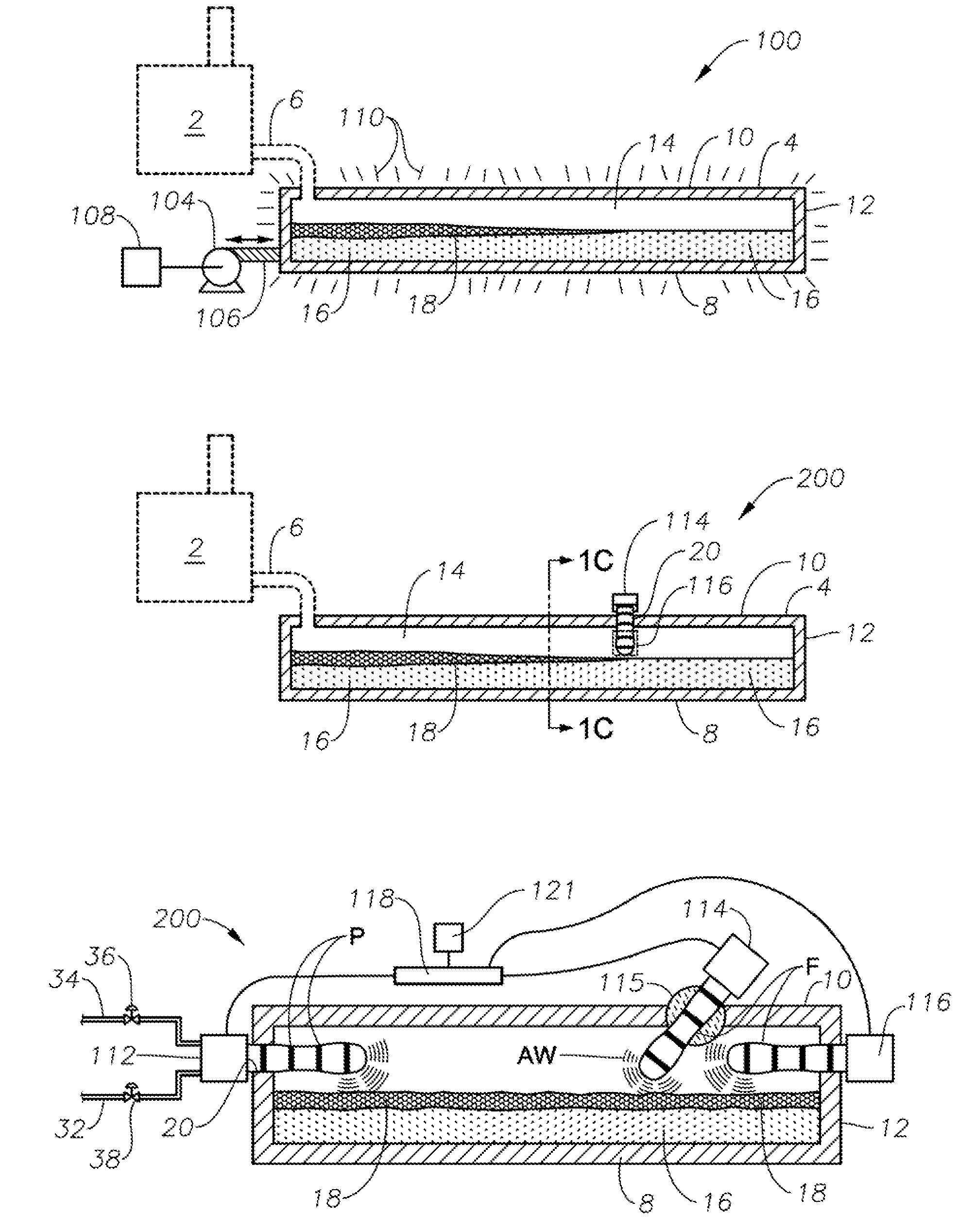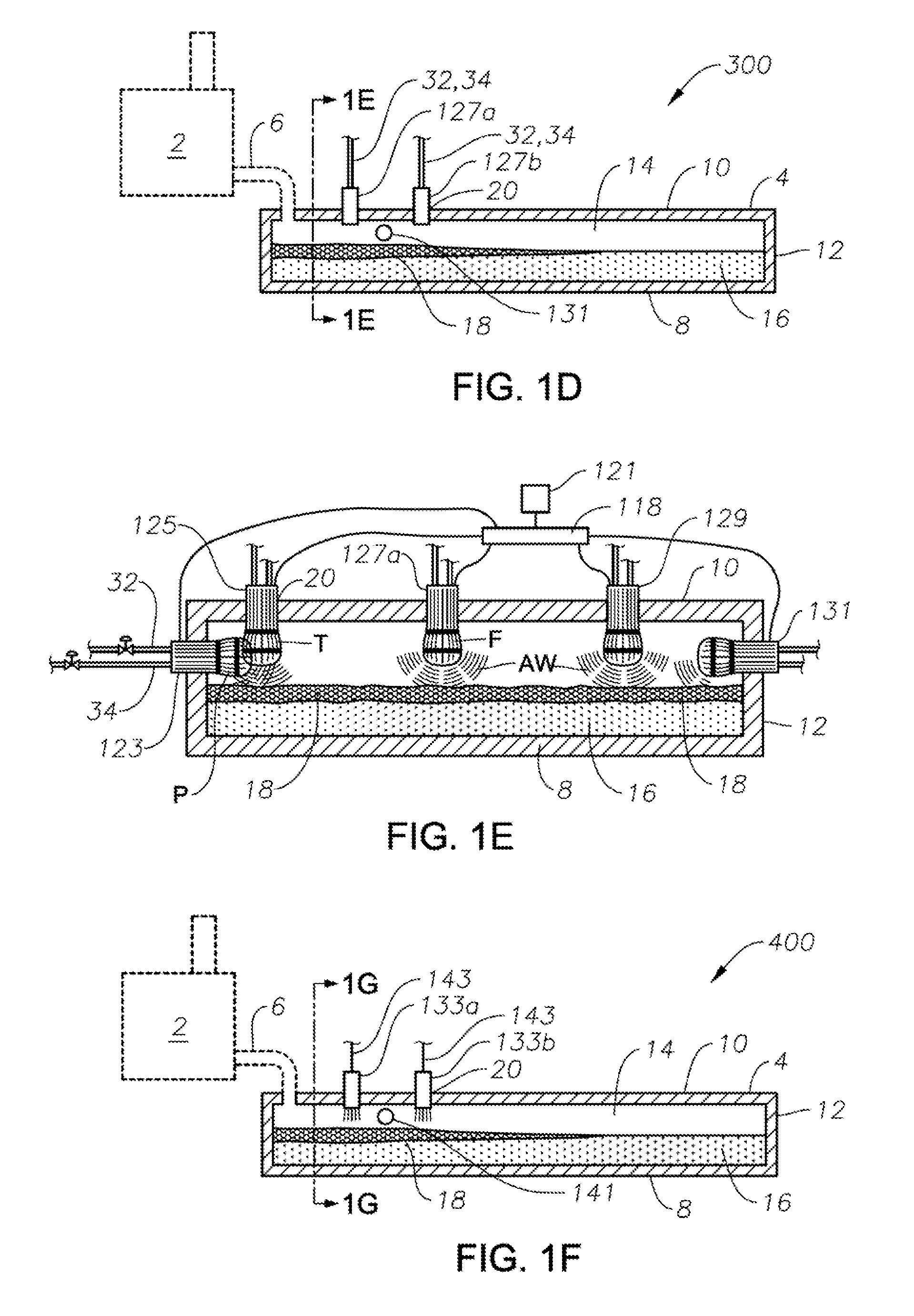Methods and systems for destabilizing foam in equipment downstream of a submerged combustion melter
a technology of combustion melter and foam destabilization system, which is applied in the direction of glass making apparatus, manufacturing tools, lighting and heating apparatus, etc., can solve the problems of high turbulence, rapid melting of glass batch, and the tendency of foam formed in the scm to be resistant to destruction or even reduction, and achieve the effect of increasing the turbulence of the molten mass
- Summary
- Abstract
- Description
- Claims
- Application Information
AI Technical Summary
Benefits of technology
Problems solved by technology
Method used
Image
Examples
embodiment 100
[0039]FIG. 1A is a schematic side elevation view, partially in cross-section, of one system embodiment 100 in accordance with the present disclosure. In all of the drawing figures where an SCM is illustrated, such as at 2 in FIG. 1A, the SCM is illustrated in dashed lines, indicating that the SCM is not, strictly speaking, a part of every system and method of the present disclosure. However, certain systems and methods may be described as comprising an SCM and one or more downstream apparatus receiving flow of molten glass and foam from the SCM. Molten glass and foam produced in SCM 2 flow into a forehearth or other downstream apparatus 4 via a melter exit structure 6, also illustrated in dashed lines. Downstream apparatus 4 comprises in this embodiment a floor 8, a roof 10, and a sidewall structure 12 connecting floor 8 and roof 10, and these components define an internal space 14 that confines a flowing or non-flowing mass of molten glass 16 having a foam layer 18 generally on a t...
embodiment 200
[0044]In embodiment 200, burners 112, 114, and 116 may be high- or low-momentum detonation combustion burners, and the combustion products or flames do not directly impinge or touch foam layer 18 to de-stabilize the foam, but rely on acoustic wave forces as described.
[0045]Another embodiment including one or more acoustic wave force generating apparatus is embodiment 300 illustrated schematically in FIGS. 1D and 1E, which may include one or more pulsed detonation engines (PDE) 123, 125, 127, 129, and 131 positioned in corresponding apertures 20 in wall 12 and / or roof 10 of downstream apparatus 4. FIG. 1D illustrates two PDEs 127a, 127b, spaced apart longitudinally along a central longitudinal axis of downstream apparatus 4. PDEs may have many constructions, but are essentially single-pipe burners having a source of fuel and a source of oxidant attached near a rear end of pipe or conduit, sometimes referred to as a barrel. As illustrated schematically in FIGS. 1D and 1E, PDEs may be ...
embodiment 400
[0046]Yet another embodiment including one or more acoustic wave force generating apparatus is embodiment 400 illustrated schematically in FIGS. 1F and 1G, which includes one or more audio speaker drivers 133, 135, 137, 139, and 141 positioned in corresponding apertures 20 in wall 12 and roof 10 of downstream apparatus 4. In certain embodiments wires 143 may connect the drivers and speakers to a controller 118 having capability of varying frequency and / or amplitude of the speaker output using a separate device 121. Controller 118 may include an amplifier, or the amplifier may be present as a separate component. In certain embodiments the speaker drivers may be wirelessly electronically connected to controller 118 and / or device 121. As illustrated schematically in FIGS. 1F and 1G, speaker drivers may be positioned in multiple longitudinal and transverse positions in downstream apparatus 4, examples being the relative longitudinal positions of speaker drivers 133a and 133b, and the re...
PUM
| Property | Measurement | Unit |
|---|---|---|
| Momentum | aaaaa | aaaaa |
| Force | aaaaa | aaaaa |
| Electrical resistance | aaaaa | aaaaa |
Abstract
Description
Claims
Application Information
 Login to View More
Login to View More - R&D
- Intellectual Property
- Life Sciences
- Materials
- Tech Scout
- Unparalleled Data Quality
- Higher Quality Content
- 60% Fewer Hallucinations
Browse by: Latest US Patents, China's latest patents, Technical Efficacy Thesaurus, Application Domain, Technology Topic, Popular Technical Reports.
© 2025 PatSnap. All rights reserved.Legal|Privacy policy|Modern Slavery Act Transparency Statement|Sitemap|About US| Contact US: help@patsnap.com



